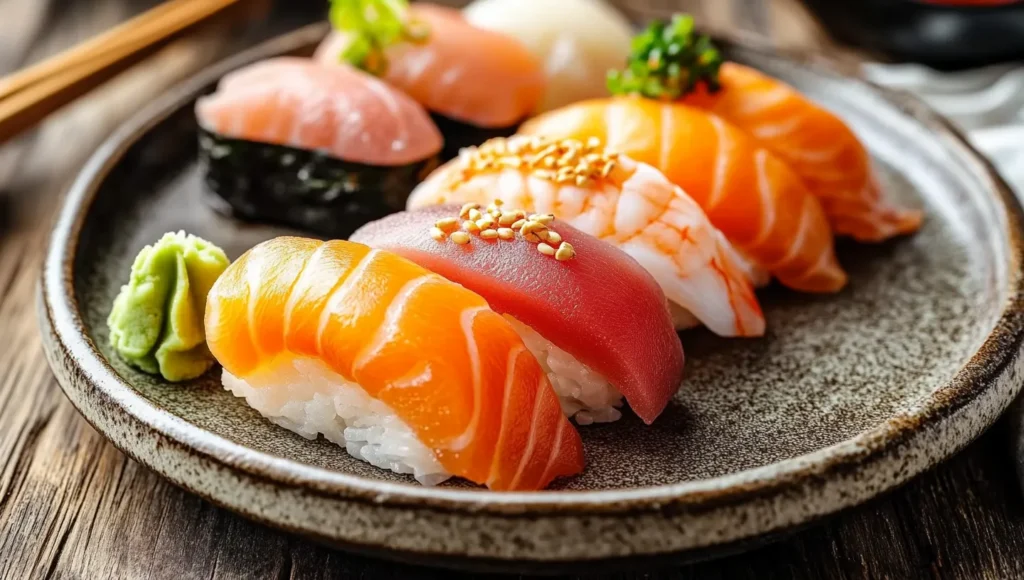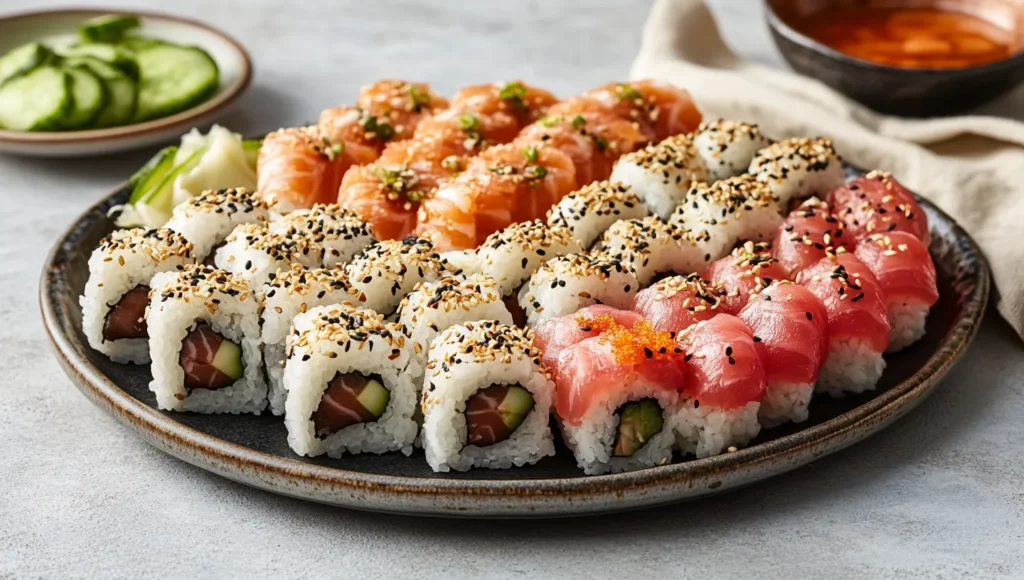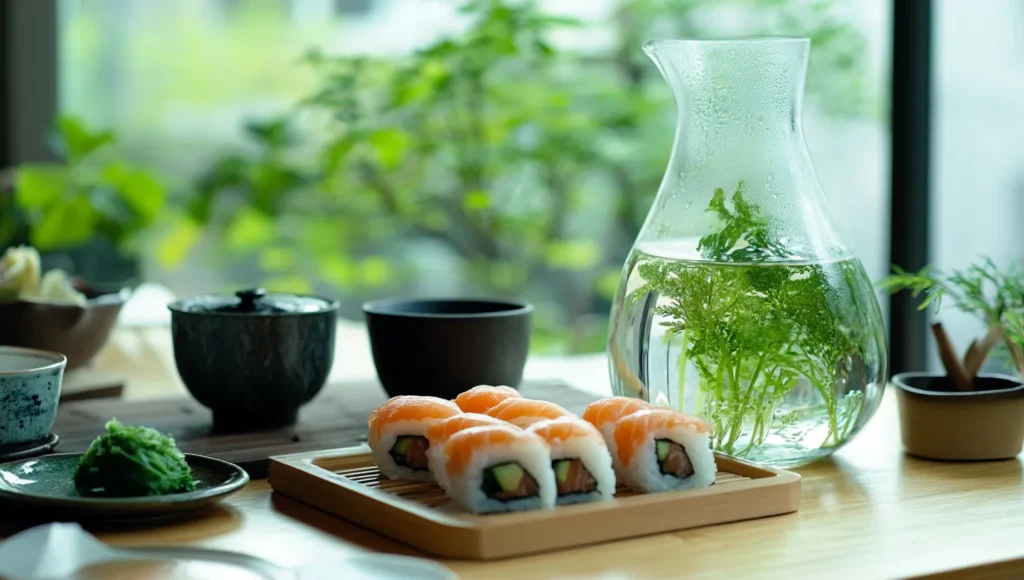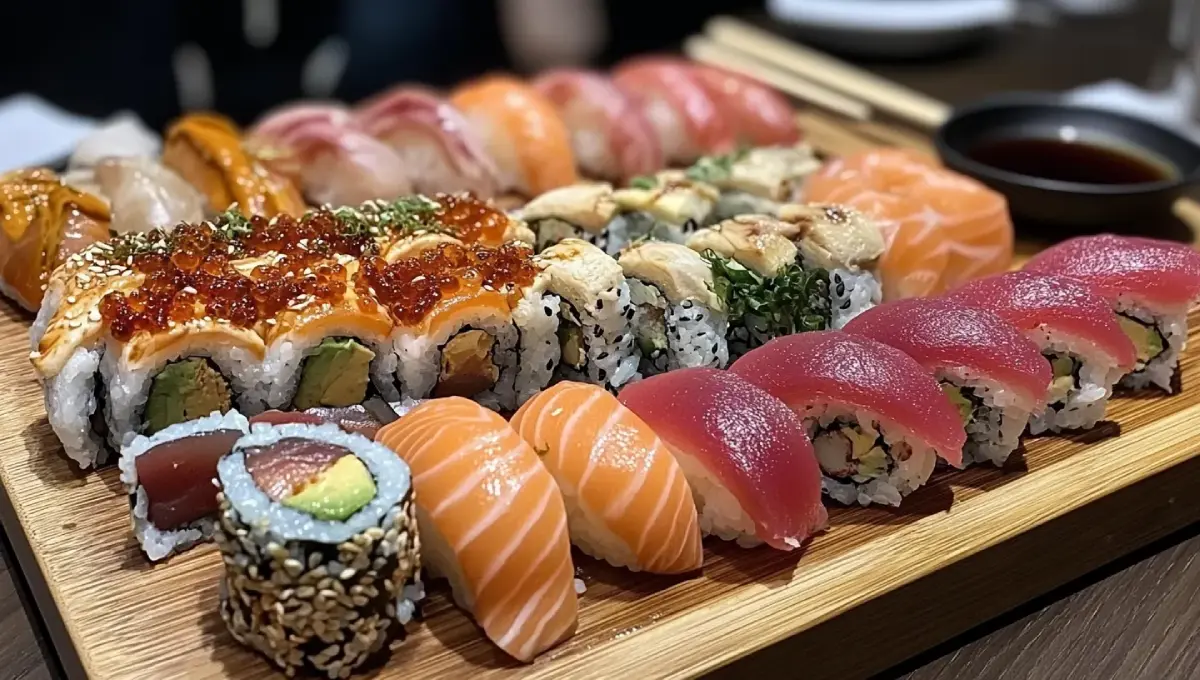Sushi is more than just a Japanese delicacy; it’s an art form that has captivated food lovers across the globe. Known for its fresh flavors, intricate preparation, and beautiful presentation, sushi represents centuries of culinary tradition. But what exactly are the three main types of sushi? In this article, we’ll dive into the fascinating history of sushi, explore its key characteristics, and uncover the differences between nigiri, maki, and sashimi. Whether you’re a sushi enthusiast or a curious beginner, you’ll gain a deeper understanding of these three staples and learn how to enjoy them like a pro.
Introduction to Sushi
Sushi has evolved into a global culinary phenomenon, but its roots are deeply embedded in Japanese culture. To appreciate the three main types of sushi, it’s essential to understand where it all began and why sushi holds such a special place in gastronomy.
The History of Sushi
Sushi’s origins date back over 1,000 years. It began as a method of preserving fish, where salted fish was packed with fermented rice to keep it fresh. This practice, known as narezushi, eventually transformed into the sushi we know today. Over time, vinegar was added to rice, not only for flavor but also to eliminate the need for fermentation, leading to modern sushi.
- By the Edo period (1603-1868), sushi became a quick street food in Japan.
- In the 20th century, sushi was introduced to the world, gaining immense popularity.
Today, sushi isn’t just a meal; it’s a cultural experience that connects people to Japan’s culinary heritage.
What Makes Sushi Unique?
Sushi is more than raw fish. Its uniqueness lies in its balance of simplicity and sophistication. The perfect sushi combines fresh, high-quality ingredients like raw fish, vinegared rice, and complementary garnishes. Each piece is carefully crafted to deliver harmonious flavors.
- Rice: Sushi rice, or shari, is seasoned with vinegar, sugar, and salt to give it a distinct taste.
- Fish: Only the freshest fish is used, ensuring its texture and flavor shine through.
- Presentation: Sushi is not just food; it’s art. From elegant nigiri to colorful maki rolls, every piece tells a story.
The beauty of sushi lies in its versatility. Whether it’s the simplicity of nigiri, the variety of maki, or the elegance of sashimi, there’s something for everyone to enjoy.
The Three Main Types of Sushi
Sushi is celebrated for its diversity, but at its core, it can be categorized into three main types: nigiri, maki, and sashimi. Each type has its unique characteristics, preparation style, and presentation. Let’s explore these sushi staples and discover what makes them special.
Nigiri Sushi

Nigiri sushi is perhaps the most iconic type of sushi. Its simplicity and elegance make it a favorite for sushi purists.
- Description and Characteristics: Nigiri consists of hand-formed balls of vinegared rice, topped with a slice of raw or cooked fish. Common toppings include tuna (maguro), salmon (sake), or shrimp (ebi).
- Common Ingredients: The rice is lightly seasoned with vinegar, and the fish is often garnished with a small amount of wasabi or brushed with soy sauce.
If you’re looking to try authentic nigiri sushi at home, this step-by-step nigiri recipe from food network is a great place to start.
Maki Sushi

Maki sushi is what many people think of when they hear “sushi rolls.” It’s versatile and offers endless flavor combinations.
- Definition and Popular Variations: Maki is made by layering rice, fish, and vegetables on a sheet of seaweed (nori), then rolling it tightly and slicing it into bite-sized pieces. Popular variations include California rolls, spicy tuna rolls, and vegetarian options.
- Ingredients and How It’s Prepared: Traditional maki often includes fresh fish and crunchy vegetables, but modern twists can incorporate cream cheese, avocado, or cooked proteins like crab.
For those new to sushi-making, this beginner’s guide to sushi rolls from AllRecipes offers easy-to-follow instructions.
Sashimi
Sashimi is all about the fish. It highlights the pure taste of high-quality seafood without the addition of rice.
- How Sashimi Differs from Other Sushi: Unlike nigiri and maki, sashimi isn’t technically sushi since it doesn’t include rice. Instead, it’s thinly sliced raw fish, served with garnishes like shredded radish or seaweed.
- Types of Fish and Presentation Styles: Sashimi typically features fish like tuna, salmon, or yellowtail, but it can also include octopus (tako) or scallops (hotate). The presentation is minimalist, focusing on the natural beauty of the fish.
If you’re dining out, opt for sashimi at a reputable restaurant to ensure the freshest and safest experience.
Differences Between Nigiri, Maki, and Sashimi
Understanding the differences between these sushi types can help you appreciate their unique qualities. Let’s break down the key distinctions.
Visual Presentation
Nigiri, maki, and sashimi are visually distinct:
- Nigiri features oval-shaped rice topped with fish.
- Maki is rolled, creating a colorful cross-section of rice, fish, and vegetables.
- Sashimi is plated simply, highlighting the natural appearance of the seafood.
Taste and Texture Profiles
The combination of rice and fish in nigiri and maki offers a balance of soft and chewy textures. Maki adds an extra crunch with vegetables or seaweed. Sashimi, on the other hand, focuses entirely on the fish’s tenderness and flavor.
Nutritional Aspects
Sushi can be a healthy meal, but the nutritional content varies:
- Nigiri and maki include carbohydrates from rice, while sashimi is low-carb.
- Fatty fish like salmon provide omega-3 fatty acids, which are great for heart health.
Sushi Preparation Tips and Recipes
Making sushi at home might seem intimidating, but with the right tools and fresh ingredients, you can create delicious rolls, nigiri, or sashimi right in your kitchen. Here’s everything you need to get started.
Tools and Ingredients You’ll Need
Before diving into sushi-making, ensure you have these essentials:
- Tools: Bamboo mat (makisu), sharp knife, rice paddle, and a bowl of water to keep rice from sticking to your hands.
- Key Ingredients:
- Rice: Short-grain sushi rice.
- Fish: Fresh, sushi-grade tuna, salmon, or shrimp.
- Extras: Nori (seaweed sheets), vegetables (cucumber, avocado), and condiments like soy sauce, pickled ginger, and wasabi.
For more detailed guidance on ingredient preparation, check out this helpful sashimi vs nigiri comparison guide on Every Tastes.
Simple Recipe for Nigiri Sushi
Making nigiri is easier than you think. Follow these steps to create restaurant-quality pieces at home:
- Prepare the Rice: Cook short-grain sushi rice, then season it with rice vinegar, sugar, and salt. Let it cool slightly.
- Cut the Fish: Slice fresh, sushi-grade fish into thin pieces, about 2-3 inches long.
- Form the Rice Base: Wet your hands, take a small ball of rice, and shape it into an oval.
- Assemble the Nigiri: Place a slice of fish on top of the rice. If desired, add a small dab of wasabi between the rice and fish.
- Serve and Enjoy: Arrange on a plate with pickled ginger and soy sauce on the side.
Sushi Etiquette and Dining Tips
Sushi is not just about taste; it’s also about tradition and etiquette. Knowing the proper way to enjoy sushi can enhance your experience, whether dining out or making it at home.
Eating Sushi the Right Way
Here are some tips to ensure you enjoy sushi like a pro:
- Chopsticks or Hands? While chopsticks are common, it’s perfectly acceptable to eat sushi with your hands, especially nigiri.
- Soy Sauce Tips: Dip the fish side of the nigiri into soy sauce not the rice to avoid overpowering the flavor.
- Wasabi Use: If you want extra wasabi, add it sparingly to your fish or soy sauce.
For additional dining tips, explore the cultural nuances of sushi in this sashimi etiquette guide from Every Tastes.
Common Mistakes to Avoid
- Overdipping in Soy Sauce: This can make the rice fall apart.
- Mixing Wasabi in Soy Sauce: It’s better to keep the flavors distinct.
- Eating Too Quickly: Savor the intricate flavors in each bite.
Frequently Asked Questions (FAQs)
When learning about sushi, many people have questions about its types, preparation, and dining etiquette. Below, we address some of the most common queries about what are the three main types of sushi.
Nigiri is often considered the most popular type of sushi, especially in traditional Japanese cuisine. Its simplicity and focus on fresh fish make it a favorite among sushi enthusiasts. However, maki rolls are extremely popular in Western countries due to their versatility and variety of flavors.
Yes, there are plenty of vegetarian and vegan sushi options available. For example, cucumber rolls (kappa maki), avocado rolls, and pickled vegetable rolls are excellent choices. Some chefs also create innovative plant-based sashimi using vegetables or tofu.
Fresh sushi has a pleasant, clean aroma and vibrant colors. The fish should feel firm, not slimy, and the rice should be slightly sticky but not mushy. Dining at reputable restaurants is the best way to ensure freshness.
Sushi can be a healthy meal, especially when made with nutrient-rich fishlike salmon or tuna. These fish are high in omega-3 fatty acids, which are good for heart health. To keep sushi healthy, limit high-sodium sauces and deep-fried rolls.
Absolutely! Cooked options like shrimp (ebi), crab (kani), and egg (tamago) are common in sushi. Maki rolls with cooked proteins or vegetables are also a great way to enjoy sushi without raw fish.
Comparison of the Three Main Types of Sushi
A side-by-side comparison of the three main types of sushi can help you understand their differences. Use the table below to see how nigiri, maki, and sashimi stack up.
| Feature | Nigiri Sushi | Maki Sushi | Sashimi |
|---|---|---|---|
| Base Ingredient | Vinegared rice with fish | Fish/vegetables wrapped in rice and seaweed | Sliced raw fish only |
| Shape | Hand-formed oval | Rolled and sliced | Thinly sliced |
| Serving Style | Individual pieces | Multiple bite-sized pieces | Minimalist presentation |
| Dietary Profile | Balanced carbs and protein | Flexible ingredients | Protein-focused |
This breakdown highlights the diversity within sushi, showing how each type caters to different tastes and preferences. Whether you prefer the simplicity of sashimi, the balance of nigiri, or the variety of maki, there’s always something exciting to try.
Exploring Regional Variations of Sushi
Sushi’s popularity has inspired regional adaptations, giving rise to unique styles worldwide. Let’s take a look at how sushi differs in various regions.
Sushi in Japan
Traditional sushi in Japan focuses on simplicity and fresh ingredients. Examples include:
- Edomae Sushi: Originating in Tokyo, it emphasizes fresh fish and vinegared rice.
- Oshizushi: This pressed sushi, from Osaka, is made by layering rice and fish in a mold.
Sushi in the United States
In the U.S., sushi often features bold flavors and creative combinations:
- California Roll: Made with crab, avocado, and cucumber, often topped with sesame seeds.
- Spicy Tuna Roll: Adds a kick with chili sauce and mayonnaise.
For more tips on making sushi rolls at home, check out our guide to sushi recipes for beginners.
Sushi Pairings and Beverage Tips

Pairing sushi with the right beverages enhances the dining experience. Here are some great options:
Drinks to Enjoy with Sushi
- Green Tea: A traditional pairing that cleanses the palate.
- Sake: Light and fragrant, sake complements sushi’s delicate flavors.
- Japanese Beer: Crisp lagers like Asahi or Sapporo are refreshing with sushi.
Side Dishes and Condiments
Pair sushi with these sides to complete your meal:
- Miso Soup: A warm and savory soup to start your meal.
- Seaweed Salad: Light and tangy, perfect with sushi rolls.
For more unique Japanese dishes, explore our guide to classic Japanese flavors.
Conclusion
Sushi is a culinary masterpiece that balances tradition, artistry, and flavor. By understanding the three main types of sushi nigiri, maki, and sashimi you can deepen your appreciation for this iconic Japanese dish. Whether you’re dining out, experimenting at home, or simply curious, sushi offers endless possibilities to explore.
Let this guide inspire you to try something new, create your own sushi rolls, or delve into Japanese culture through its cuisine. Sushi truly has something for everyone, from purists to adventurous eaters.
Print
Classic Nigiri Sushi Recipe
- Total Time: 50 minutes
Description
Learn how to make nigiri sushi at home with this easy and delicious recipe! Perfect for beginners and sushi enthusiasts, this step-by-step guide ensures success every time.
Ingredients
- 2 cups short-grain sushi rice
- 2 ½ cups water
- 3 tablespoons rice vinegar
- 1 tablespoon sugar
- ½ teaspoon salt
- 8 oz sushi-grade tuna or salmon (thinly sliced)
- Wasabi (optional)
- Soy sauce and pickled ginger (for serving)
Instructions
- Cook the Rice:
Rinse the sushi rice under cold water until the water runs clear. Combine rice and water in a rice cooker and cook until done. Let it cool slightly. - Season the Rice:
In a small bowl, mix rice vinegar, sugar, and salt. Gently fold the mixture into the rice using a wooden spatula. - Prepare the Fish:
Slice the sushi-grade fish into thin, even pieces, about 2-3 inches long. - Shape the Rice:
Wet your hands with water to prevent sticking. Take a small ball of rice and shape it into an oval. - Assemble the Nigiri:
Add a small dab of wasabi (if desired) on one side of the fish slice. Place the fish on top of the rice and gently press to secure. - Serve:
Arrange the nigiri on a plate. Serve with soy sauce, pickled ginger, and additional wasabi on the side.
Notes
- Use sushi-grade fish for safety and quality.
- Serve immediately for the best flavor.
- Customize with shrimp, scallops, or other toppings if desired.
- Prep Time: 20 minutes
- Cook Time: 30 minutes
Nutrition
- Serving Size: 4
- Calories: 5g
- Fat: 5g
- Protein: 20g
Keywords: Classic Nigiri Sushi Recipe

